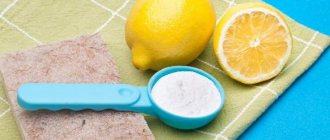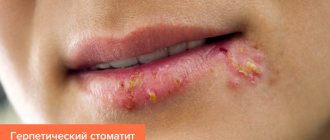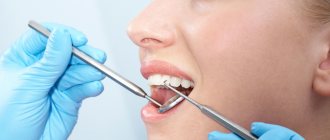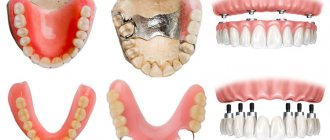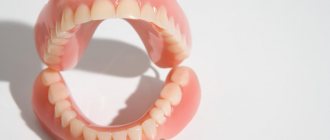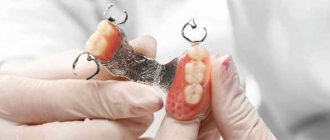Very often, various situations arise that lead to breakage of dentures. A logical question immediately arises: how to glue a denture together? At home, you can carry out minor restoration using special glue and cement. But the quality of repair work depends on the quality of preparation of the structure. It includes thorough cleaning, after which the gluing process begins. If the repair was performed efficiently, the strength of the prosthesis does not decrease.
Why do removable dentures made of plastic break?
There are many reasons that lead to the breakdown of structures, but you can organize repair of removable dentures at home. So, the reasons:
- Wrong work done by a dental technician. If the impression was taken incorrectly, the finished design will not be the correct size. To do this you need to sharpen it.
- Low-quality materials were used to make the prostheses; for example, when examining the finished product, you can see frozen air bubbles. Such a prosthesis is prone to deformation.
- Errors made during laboratory manufacturing can result in uneven distribution of chewing load or lack of a tight seal.
- If you carelessly care for the products and eat solid foods. In such a case, you should pay attention to the question of how to properly clean dentures at home.
- Using a solution that is not suitable for maintenance.
- Changes in the jaw apparatus (occur over time), leading to a loose fit of the structure.
- Long-term operation when the service life of the product ends.
Main causes of damage
Defects on dentures occur for various reasons, which are associated with external influences or improper use. Repairing the damage depends on the specific cause.
Fall of the structure
Throughout the entire process of wearing removable dentures, you should avoid dropping them on a hard surface. Often the product is damaged as a result of hitting a tiled floor or sink during cleaning. A fall even from a small height can lead to the formation of chips and microcracks.
High load
To avoid damaging the structure, you should avoid eating hard and too hard foods, including crackers and nuts. Solid food increases stress on the product and causes defects.
Reducing the load can also be achieved by removing the prosthesis at night and storing it in a glass of water or in a damp cloth.
Loss of an abutment tooth
If the structure is fixed in the oral cavity on an abutment tooth, its loss leads to displacement of the product. As a result, the risk of defects in the dentures increases.
Errors during operation
Violation of the basic rules for using a prosthesis is a common cause of its damage. When the need arises to install dentures, it is better to immediately familiarize yourself with the nuances of operation in order to avoid mistakes.
What to do if your denture is cracked or broken - step-by-step instructions
The first question that arises is how can you glue a denture at home if it breaks? Be sure to contact the clinic. Only there will they help determine the severity of the defect. It may be possible to seal the prosthesis or have to make a new one. Sometimes fixing a defect will cost more than making a new design. In addition, independent repair (for example, if you have to adjust the fastener without experience) can lead to complete breakdown and further unsuitability of the product, even if an experienced specialist undertakes the repair.
When repairs are needed
Reasons why structural repairs are required:
- change in color of artificial teeth. You should not try to whiten dentures yourself;
- discomfort when using structures for their intended purpose, which has not occurred before;
- chips and cracks - one of the most common breakdowns, occurs due to uneven chewing load when chewing solid food;
- loss of one or more crowns;
- poor fixation to the oral mucosa due to natural subsidence of the bone tissue of the alveolar processes.
Read Dentures with suction cups - how to use them, storage and care of such dentures
Should you glue a broken denture with superglue?
How to glue a denture in case of mechanical damage at home? For gluing, we can assume that regular superglue will do. In fact, this is a wrong and erroneous decision. It is not intended for this purpose; it is toxic and has an unpleasant taste. Under the influence of superglue, the prosthesis will deteriorate and will not be repairable.
In such cases, it is necessary to use special products designed specifically for gluing. But under no circumstances should you use unknown household materials. Since this can cause not only final breakdown of the structure, but also your own poisoning.
Removable Device Recovery
Removable ones include acrylic systems, dentures with locks (attachments) without an artificial palate, clasp ones, where the base is metal arches, soft Quattro Ti, as well as thin and light Acry-Free.
The manufacture and repair of removable orthopedic appliances is one of the most popular types of dental care. Basically, their base is made of a monolith, the fracture of which can extremely rarely be repaired - only chips and broken hooks can be restored. When artificial crowns fall out, they are replaced by simply soldering them into place. When artificial enamel is chipped, it is restored using composite materials.
The situation is more complicated with clasp dentures if the metal arches that need to be soldered are damaged. Let’s look at how removable dentures are repaired and what stages the renovation may consist of using the example of reconstructing damage to a plate or acrylic denture:
- after cleaning, all parts are put together in the correct relationship to each other and fixed using adhesive wax and special holding devices,
- using a brush, an insulating substance is applied to the prosthetic bed (the back part that will face the plaster) to prevent sticking to the plaster model,
- To hold all the parts together, a backing is made from class I gypsum - a sub-cast that follows the shape of the patient's jaw. All parts connected in the first point are separated again, the broken edges are processed with cutters. The processed parts are placed on the lining, like a puzzle,
- the edges of the broken bevels are processed at an angle of 45 degrees to the base to ensure a smooth transition between the old and new plastics and their good adhesion to each other,
- a liquid insulating material is applied to the plaster so that moisture from the gypsum does not get into the new plastic,
- the parts to be glued are treated with monomer and fixed to the model,
- knead the plastic, strictly following the instructions for the ratio of components, and apply it to the joints of the disparate parts with a slight excess, after which it is polymerized in a special apparatus,
- Once the new resin has hardened, the excess material is removed and the surface of the denture is leveled, sanded and polished until smooth.
In case of other breakdowns, the steps may be different and complex devices and tools may be used. Cast metal arches - clasps - are difficult to repair. To do this, teeth and gums made of polymers are removed from the arch, and the broken metal parts are soldered together using a laser. Self-hardening adhesives are also used for acrylic devices. If there is no element in the form of an artificial tooth, then a plastic one can be built up, and a ceramic one can literally be “implanted” at high temperatures.
Nylon prostheses are glued together with special liquids, but the special technology of their manufacture often makes them unsuitable for repair. In addition, they are one of the most flexible to stretching and changing shape; even with a short period of use, they often require adjustment.
Repairing a removable denture
It is unlikely that it will be possible to repair a prosthesis at home efficiently and for a long time. For help, you will have to contact a dental laboratory, where a suitability examination will be carried out, an assessment will be carried out and repairs will be suggested. This will take several days.
Features of restoration
Restoration is carried out as follows. Special glue is poured into the crack. Once it dries, plaster is applied on top. After the time required for the plaster to dry, the structure is separated and sanded without touching the oral mucosa. After this we need acrylic. It is applied to artificial crowns and polished after hardening. The finished denture is polished, without noticeable defects, and looks like real teeth. Only a dental technician can make and repair the structure. For this he uses special materials. However, not all dentures can be repaired. It is impossible to restore structures made entirely of plastic or stamped products.
What is used for gluing
At home, you can temporarily fix the structure with special glue, which is sold in a specialized store. For example, a special adhesive composition is suitable for this purpose. However, such a design will not last long. It is recommended to seek professional help as soon as possible.
So, gluing instructions - step 1
We will need medical plaster in order to make a base on which the prosthetic structure will rest (photo), it can also be made from wax (all means are good at home):
Step 2 - gluing option without reinforcement
The second step in our repair, after the impression has been created and has assumed a strong (frozen) state, we can begin gluing the prosthesis (photo):
Please note that we glue the plate prosthesis with a liquid acrylic mass, having previously prepared the necessary solution. Of course, for this you need to have a pre-prepared acrylic-m repair kit in your home pharmacy; you can buy it at a pharmacy or order it from a specialized online store:
Colorless plastic for repairing plastic dentures
Analogues of liquid acrylic
Analog "Acryl-M"
Step 3 - gluing with titanium mesh reinforcement of the base of the prosthesis
If we want to make the prosthesis even stronger, and also so that it will serve us for a longer period, we just need to add a metal mesh to the base to strengthen the structure:
This mesh is placed at the base of the prosthesis structure, pre-adjusted in size, and then filled with a liquid acrylic solution. The thickness of the layer should be such that it covers the reinforcing mesh:
After all repair work has been carried out on the prosthesis, let the acrylic harden - the recommended period is indicated in the instructions. Although hardening can also be determined by the hardness of the structure.
Read Dental bridges: types of dental bridges, what crowns are made from, materials and care
Next, the prosthesis needs to be washed well and, if necessary (or if possible), polished. After which the prosthesis can be used further for its intended purpose!
Prices for repair work
The price of repairs made in a dental laboratory is slightly different from those made in a dental office. But at the same time, the quality and accuracy of the repaired structure will be incomparably higher due to the presence of a large amount of equipment and specialist technicians.
In general, the cost of restoring integrity is low, ranging from 500-800 rubles for minor damage and reaches 7-8 thousand rubles for complex restorations.
- Afanasyeva V.V. Increasing the efficiency of restoration of removable plate dentures after breakage / Afanasyeva V.V., Lebedenko I.Yu., Grachev D.I., Arutyunov S.D. // Russian Dental Journal. – 2014. – No. 5.
- Markov B.P., Lebedenko I.Yu., Erichev V.V. Guide to practical dentistry. M.: Ministry of Health of the Russian Federation, 2001.
Author: Sambuev B. S. (Thank you for your help in writing the article and the information provided)
Restoration of the prosthesis in the clinic
Only a specialist can fully repair the prosthesis. After inspection, the extent of its damage is determined. Then a suitable method of denture restoration is selected. Laboratory and clinical methods are used in the recovery process. Before repairs, your dentures should be thoroughly cleaned. If the surfaces are poorly cleaned, it will be impossible to glue. A special adhesive composition is used for gluing. A specialist must carefully match the surfaces to be glued. If it is not possible to fix the prosthesis or there is a lot of damage, then a new structure is made instead. If a fracture of the denture is accompanied by the loss of the crown, then it can be glued and the crack can be soldered. The result should be a monolithic structure without visible defects and irregularities.
How to glue a structure at home
Repairing a structure is called restoration. Breakage brings inconvenience to life; it is necessary to remove the prosthesis, take it to the workshop and do without it for some time. Minor damage can be repaired yourself. To do this, you need to purchase special dental glue, as well as assess the degree of damage and plan the stages of repair.
For high-quality gluing you will need glue, wax, auxiliary tools, and plaster. It is recommended to glue a dental bridge or carry out repairs as follows:
- Wash the structure thoroughly with soap and dry.
- Give the prosthesis its original shape, fasten the parts with fixing elements and wax.
- Apply diluted plaster to all parts.
- After the plaster has hardened, remove the structure and clean it from dust.
- Apply the product along the dotted line to the plaster in places of breaks, chips and cracks.
- Place the prosthesis on the plaster model, apply glue, and let it stand.
Price issue
Depending on the material from which the structure is made and the severity of the damage, the cost of repairs may vary. To eliminate a crack, fracture, or restore ceramic-metal products, you will have to pay up to 1,800 rubles. The cost of a broken crown will be approximately 2,500 rubles. Polishing the prosthesis, professional cleaning, after disinfection will cost 1000 rubles.
Thus, the cost depends on the amount of work performed, the severity of the breakdown, and the material with which the specialist has to work. If you want to save money on professional repairs, then you should prepare for the fact that a fitted prosthesis repaired by yourself will soon fall apart.
Video - repairing a nylon prosthesis
You can learn how to make dentures at home by watching the video. The nylon prosthesis itself, if its shelf life has not passed, is difficult to break quite easily, but if you seriously approach such an issue as repairing nylon prostheses, then it is still better to contact a specialist. Known failures of a nylon prosthesis may include the loss of an artificial tooth.
According to the recommendations of a specialist (dentist - orthopedist) on the YouTube channel, it is possible to make a denture at home, but the best quality work will remain that which was carried out in a dental laboratory. It makes sense to repair a prosthesis in the following cases:
- design no more than 2 years from the date of its manufacture;
- it is possible to weld a new cover in the form of a clasp;
- if several teeth are missing in the mouth.
If the denture is more than 3 years old, there is no point in repairing it, and also if more than 3 teeth are missing in the mouth. Repairing dentures is less expensive than making a new one. If you lose 4-6 teeth, there is no point in repairing a nylon denture, since making a new one will cost the same as repairing an old denture.
But under no circumstances should you use unknown household adhesive materials. Since this can cause not only final breakdown of the structure, but also your own poisoning.
Repairing a plastic prosthesis
How to make a denture at home if it is made of plastic? The tips below will help you fix the situation with a minor breakdown. First you need to assess the extent of the damage. The work will require special materials (for example, acrylic), which can be purchased in dental stores.
- It is recommended to wash broken fragments with special care in a soapy solution and then dry thoroughly.
- Install the halves and connect them clearly along the fault line, apply wax.
- Dilute the plaster, which should be placed on the product from all sides.
- After the plaster has hardened, the prosthesis is carefully separated from it.
- Grind the chip line at an angle of 40%. You should not touch the surface that will be adjacent to the oral mucosa.
- According to the instructions, prepare the material (plastic) for pouring.
- Apply the prepared mixture to the plaster model and leave until hardened.
- The resulting hardened structure is ground and polished.
- Finally, the finished prosthesis must be washed in soapy water.
Read Total dental prosthetics of the upper and lower jaw: prosthetics with crowns and removable dentures
Making a prosthesis at home is a labor-intensive task that requires special equipment, time, and skill. This manipulation is resorted to when it is not possible to contact a dentist in the near future.
Repair features
Each case is individual: there is no general repair scheme. It all depends on what material the prosthesis is made from and the type of failure. Let us remind you that there are several types of dentures:
- Acrylic;
- Byugelny;
- Nylon;
- Polyurethane.
For example, breakage of an acrylic prosthesis often occurs, which is explained by the fragility of the material itself. In such a product, the base is mainly broken. If this is a clasp prosthesis, then it has a certain service life after which the product loses its functions. But its repair is not easy. All this is explained by the complexity of the design itself. Depending on the type of defect, different repair methods are used: gluing, sealing parts of the product into one whole.
Rules for caring for fixed dentures
How to clean fixed structures so that they last as long as possible:
- Carry out oral hygiene regularly (at least 2 times a day) - clean dentures in the morning and evening using powder or paste;
- It is important to pay attention to hard-to-reach areas. If, after prosthetics, bacteria get under the structure, an inflammatory process may develop. Rinsing with various compositions will help to disinfect. They can be purchased in stores or pharmacy chains, or you can make them yourself (herbal decoctions: calendula, chamomile, etc.);
- It is recommended to use dental floss and irrigator. Such devices will help remove plaque and food debris from hard-to-reach areas.
It is important to periodically visit a specialist who can detect minor chips, cracks and restore the structure before it is seriously deformed.
Repair methods for dental technicians
When contacting a specialist, the repair method is determined after examining the damaged dental structure. To eliminate the defect, the use of specialized equipment and additional materials may be required. Each of the repair methods discussed below has certain nuances of implementation and requires a professional approach.
Filling with plastic
To fill a crack in a denture, dental technicians perform a series of steps in sequence. Including:
- Before shaping the product, the surface is degreased with monomer. The damaged area is then filled with molten plastic and the material is smoothed out by hand.
- To ensure an even coating, professionals often use dental instruments with thin bases of different shapes.
- The surface of the plastic is covered with a moistened cellophane plate and placed in a dental press to fix the material.
- If there is excess plastic, it is cut off along the edge of the product.
- The structure is placed in a polymerizer, which provides slow heating, boiling and cooling. This method of polymerization reliably bonds the plastic to the main part and has a positive effect on the final quality.
Dental resin
Dental resin is used to build up the damaged area. The specialist selects a composite material of a suitable shade and applies it to the site of the chip or crack. Resin augmentation is convenient when chipping a small piece of a prosthesis.
Wax is intended for modeling facets, crowns and other parts of fixed dentures. The composition for working with dental products is based on paraffin, natural resin and natural wax. The advantages of the material include:
- low thermal shrinkage;
- ash content up to 0.02%;
- easy modeling using dental instruments;
- formation of dry and inviscid chips.
Laser welding
The laser solderless welding process creates a tear-resistant weld that has improved twist, displacement and flex characteristics compared to a soldered weld. The technology eliminates the occurrence of cracks and deformation of the product, ensuring high precision adhesion of individual parts.
Single tooth restoration
Artistic restoration of an individual tooth is a set of measures that help eliminate aesthetic errors. The result of restoration is changing the irregular shape of the teeth, adjusting their position, filling the interdental space, and changing the shade of the enamel. By restoring the tooth, you can partially or completely get rid of the prosthesis.
If the clasp or fastening lock is broken
Clasp systems and fastening locks mechanically hold the dentures in one place, preventing displacement. The breakdown of one of the parts requires a complete replacement, since broken small mechanisms can rarely be repaired.
How to care for removable dentures
How to clean and properly care for dentures at home? The right question for those who have started using removable structures. Because the service life of dentures depends on the care they take. Crowns often darken due to plaque. The reason for its appearance is insufficient care. The surface of the structures is slightly rough, so dyes from food and drinks easily penetrate into it. How to clean dentures at home, and what solutions are suitable for this?
The easiest way is to clean with a special tooth powder or tablets. Dentures are 10 times softer than tooth enamel. Regular toothpaste contains abrasives that scratch the surface of artificial crowns, which promotes the accumulation of bacteria that cause an unpleasant odor. To do this, you should use specialized products available in tablets. It is recommended to add one tablet to a glass of water. The prosthesis should be immersed in the solution for no more than 3 minutes. Before use, the product should be removed and washed under running water.
It is recommended to remove the prosthesis twice a day to remove any remaining adhesive. Among the available cleaning products, you can use regular baking soda applied to a brush. It can be dissolved in the amount of 1 teaspoon per glass of water to prepare a solution in which the prosthesis is stored after removal.
It is possible to prevent the occurrence of plaque and stone by periodically boiling the denture for several minutes. Diluted vinegar or citric acid removes dark deposits well.
Dentures will remain a reliable design if they are properly cared for, according to the above recommendations, and protected from various mechanical damage.
Is it possible to glue a prosthesis with Moment glue?
Instant glue “Second”, “Moment”, “Super” and other trade names are available for sale. The point is not in the title, but in the content. This is cyanoacrylate. A substance that has excellent adhesion to most polymeric and inorganic substances. Its main advantage is its very fast setting.
It is ideally suited for gluing plastics. It would seem that there is no need to invent any special compositions - just apply a few drops of “Super Moment” and the prosthesis is ready for use again.
Not so simple. There are more negative points than positive ones:
- The glue contains a deadly cyanide base;
- “Super” glue is poorly resistant to aggressive environments and water. In them it quickly collapses. Microorganisms living in the oral cavity destroy the adhesive bond in 14-20 days. After this, the prosthesis will have to be repaired again.
- During the gluing process, a bead of dissolved acrylate is formed. In sensitive people, it can injure the palate and tongue.
- The glue is extremely fluid. It is difficult to accurately apply it to the edge of the fracture. Leaked glue dissolves the surface of the prosthesis and makes it rough. Because of this, the effect of suction to the palate is reduced. The prosthesis begins to wobble. Residues of food accumulate under it.
- It can only be used in an emergency situation, far from the centers of civilization. A prosthesis repaired in this way is not subject to warranty repair. And for restoration in a workshop you will have to pay at least double the price.
In conclusion, it remains to be stated that any dental workshop is a faithful and reliable friend in matters of repair and restoration of dentures.
Fittydent
Available for sale in tubes of 20 and 40 ml. The product is not suitable for people with hypersensitive gums - burning and tingling may occur during its use.
Advice! To prevent unpleasant sensations, wait until the glue applied to the prosthesis dries a little, and only then attach it in the oral cavity.
Advantages:
- there are no traces of glue on the gums after removing the structure;
- there is no pronounced taste;
- securely fixes;
- duration of action is up to 12 hours;
- waterproof.
Flaws:
- can be applied exclusively to a dry prosthesis;
- viscous;
- Not suitable for those with sensitive gums.
